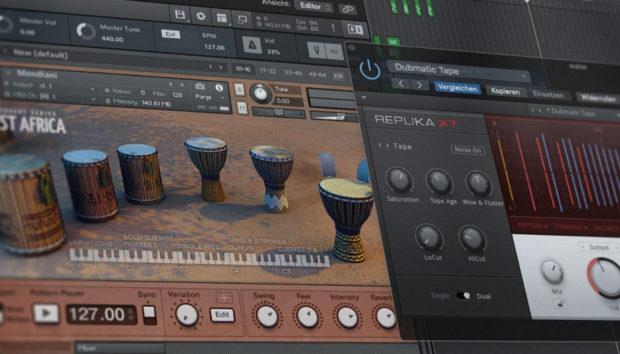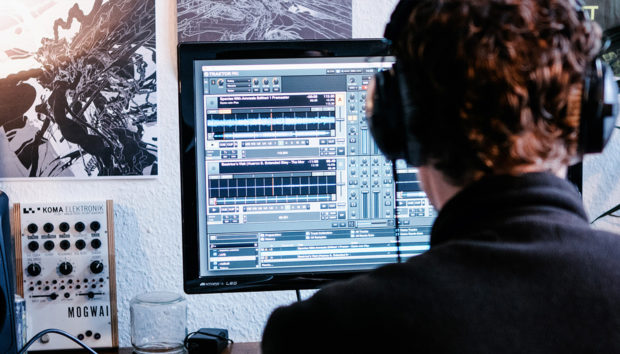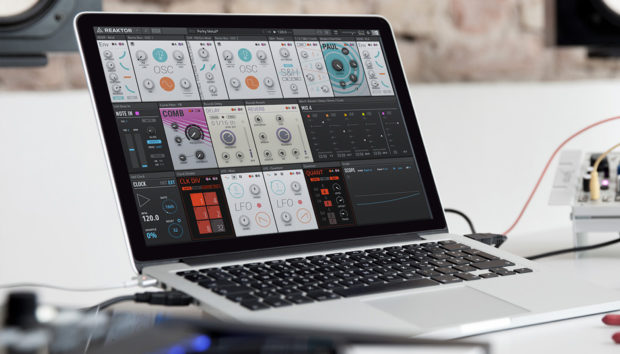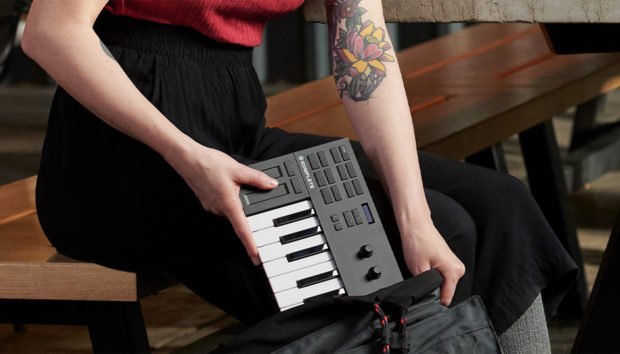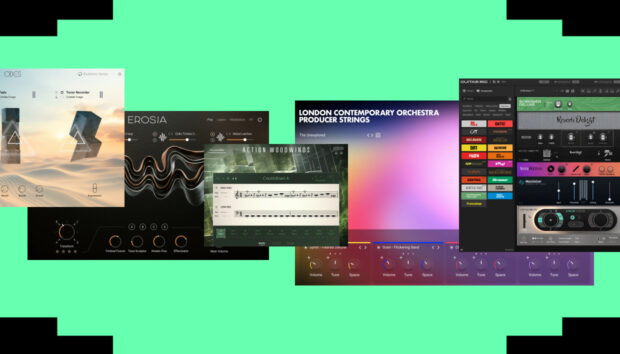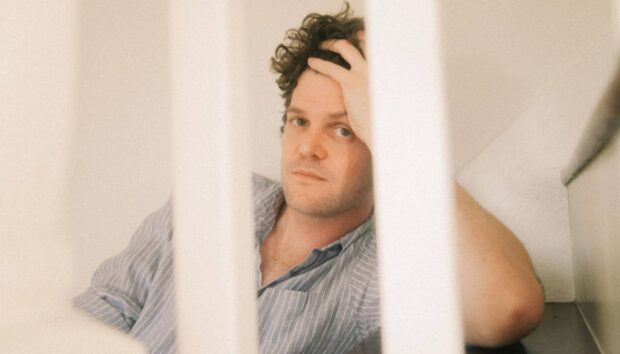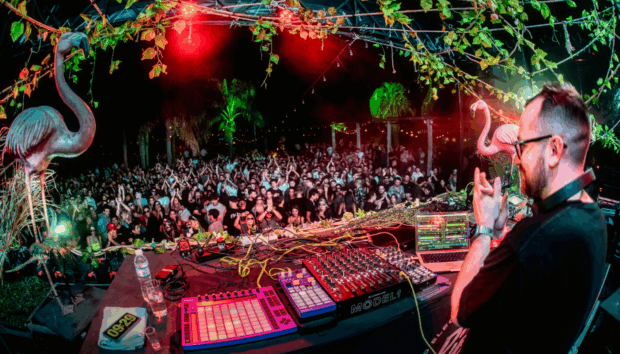David Castellani’s new EP Self Saboteur, out now on his Noetic label, builds on years of modular synthesis, distortion-heavy processing, and cinematic arrangement work. Whether he’s shaping vocals, tightening low end with parallel distortion, or pushing chaos through pitch pedals, Guitar Rig has been part of that process from the start.
In this interview, Castellani explains how he uses Guitar Rig in techno production workflows, how he automates movement using mapped MIDI controls, and why he’s increasingly leaning on its flexibility across vocals, synths, and full buses.
Jump to these sections:
- How Castellani uses Guitar Rig on vocals, synths, and full return chains
- Why distortion and saturation need to stay focused in the upper mids
- How he automates FX using MIDI mapping for live-sounding results
- What presets and starting points help speed up studio decisions
- Where he sees Guitar Rig fitting into future live performances
- Why he still thinks most techno producers are underestimating it
Here’s how Guitar Rig fits into Castellani’s latest work and why it’s become one of his most trusted tools in and out of the studio.
Plus, get some of David’s go-to Guitar Rig presets to help you perfect your sound below for free.
How do you approach Guitar Rig in your chain – on individual tracks, groups, or as a send/return?
I’ve been using it for what feels like decades – though I’m not even certain how long it’s actually been on the market. It’s one of those tools that has become deeply integrated into my workflow, almost like it’s been there since the beginning.
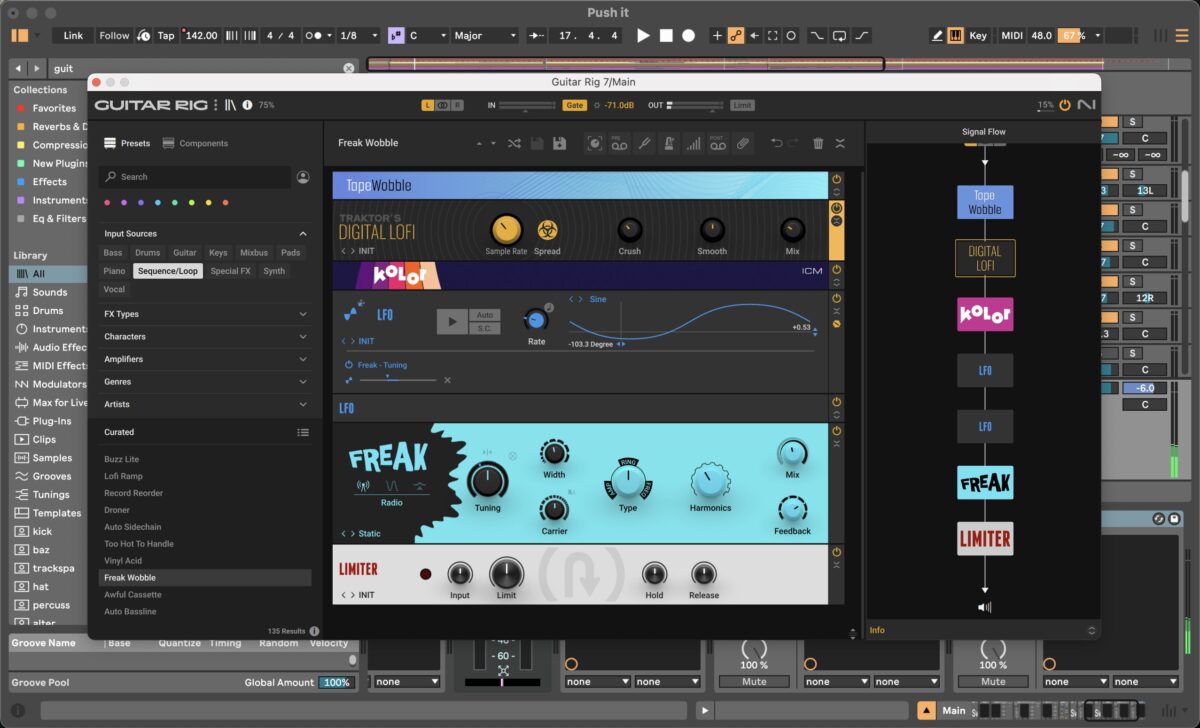
Early on, I primarily used it as a vocal processor, specifically leveraging its pitch shifter. It consistently delivered clean, reliable results, and I ended up using it on a significant number of productions.
That said, vocal processing is far from the only reason I reach for it. Guitar Rig also excels as a distortion unit and offers a wide array of other effects – making it an incredibly flexible tool for everything from subtle enhancements to wildly intense sound design. Whether I’m after saturation, filtering, modulation, or spatial effects, it’s capable of handling it all with precision.
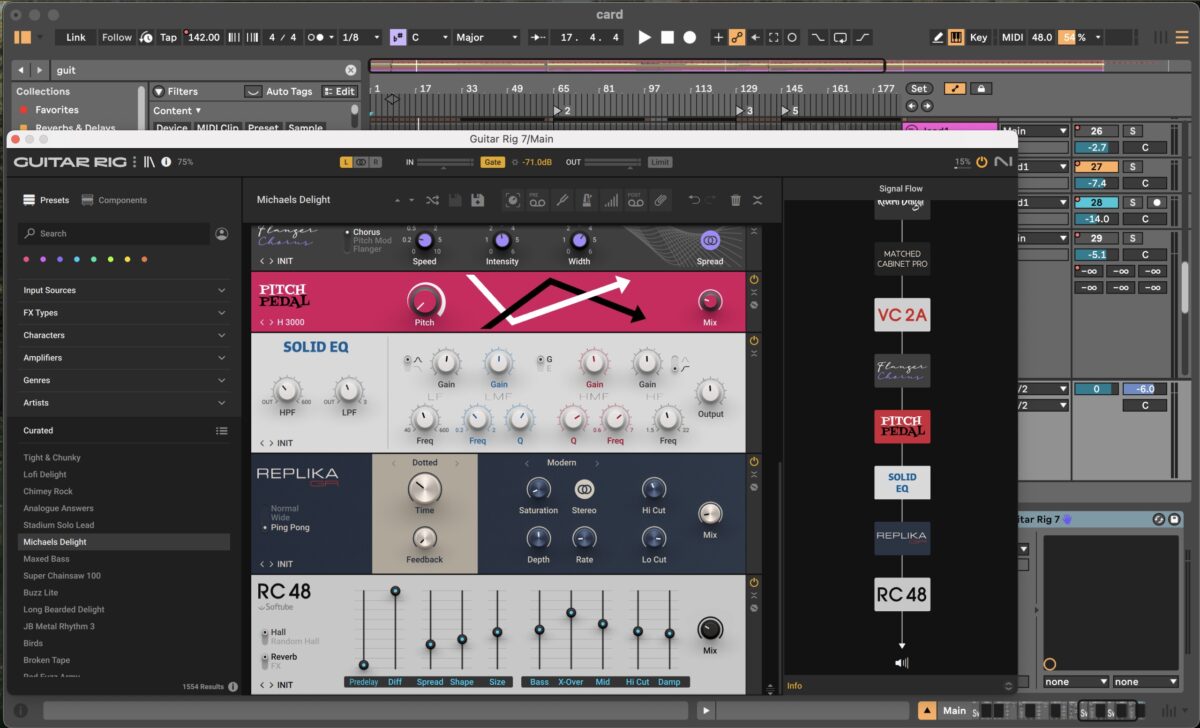
As for how I integrate it today – I don’t adhere to a single use case. Like many tools in my arsenal, I apply it contextually: sometimes on individual tracks, occasionally on return channels for parallel processing, and in some cases, even across the master bus when I’m looking to push boundaries or experiment with harmonic coloration and dynamics.
Pro tip from David Castellani: Try using the Pitch Pedal on your vocal chain – it always does the trick.
Techno thrives on tension and controlled feedback – how do you use Guitar Rig to create instability without losing clarity?
I’ve become more and more of a distortion addict as the years go by. I’m constantly chasing that sweet spot – a blend of intensity, fidelity, and clarity in my mixes.
One of the techniques that’s worked well for me is focusing saturation and distortion primarily on elements that live in the upper mids and high frequencies, keeping the low end as clean and tight as possible. Guitar Rig has been a key tool for this, especially with its wide range of saturation and distortion modules.
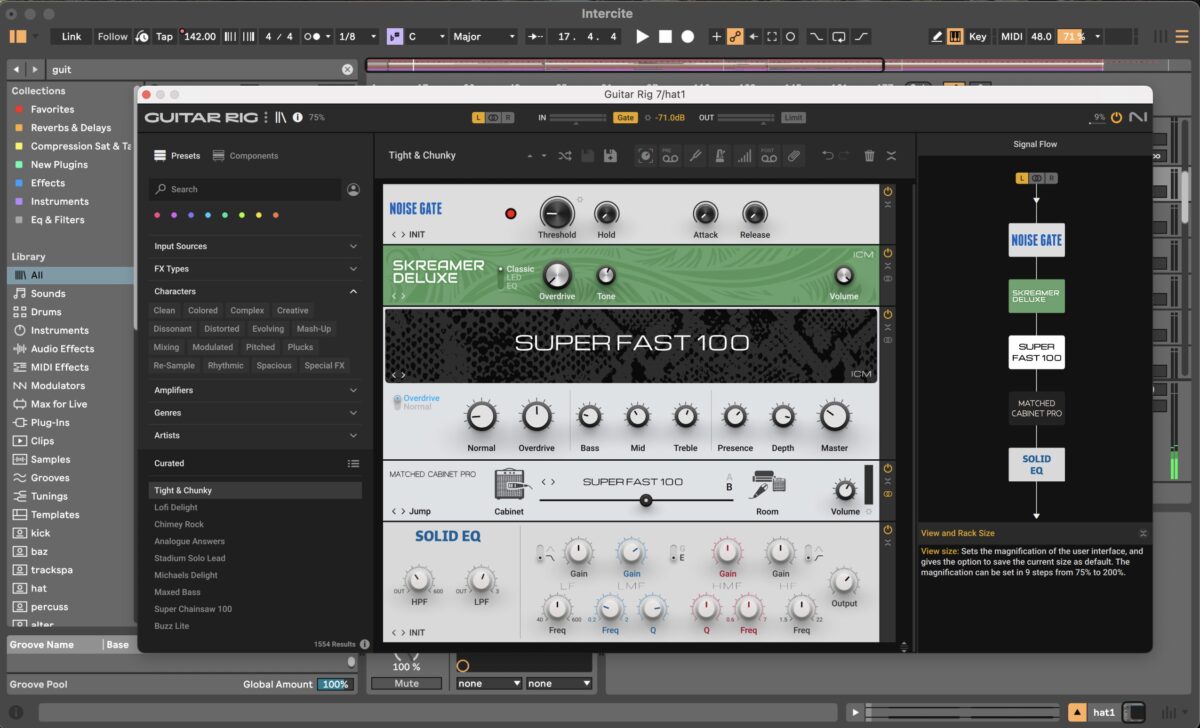
Another effective approach I often use is parallel distortion on a return channel. I’ll usually high-pass the input signal before it hits the distortion unit to keep the low-end from getting muddy – this keeps the grit in check while still delivering impact.
That said, sometimes I’m not chasing “clean” at all. There are moments when I deliberately want to inject dirt and chaos into the sound to shape a more aggressive vibe. Guitar Rig is incredibly useful in that territory, too. Its huge selection of amp models, cabinets, and pedal emulations offers an almost endless amount of tonal variation and creative possibilities. Whether I’m looking for subtle harmonic excitement or full-blown sonic destruction, there’s always a combination in there that gets me where I want to go.
I’m currently working on a new project – can’t say too much just yet – but it’s heavily inspired by heavier, more distorted sonic palettes. Lately, I’ve been using Guitar Rig across everything: vocals, synths, drums, and yes… sometimes even the master bus (I know, it’s taboo). But sometimes you have to break the rules to really make a statement.
Pro tip from David Castellani: The Traktor DJ-like effects (mainly under the Special FX section) can be surprisingly useful on individual sounds. Try the Ring Mod on a synth lead to blow things.
How do you build rhythmic movement inside Guitar Rig that complements sequenced patterns from your modular setup?
One of my absolute favorite aspects of Guitar Rig – especially compared to many larger, multi-module effect or sound design plugins – is how easy it is to MIDI map to any controller. This makes it incredibly fast and intuitive to assign parameters directly to knobs, faders, or buttons on my MIDI controller.
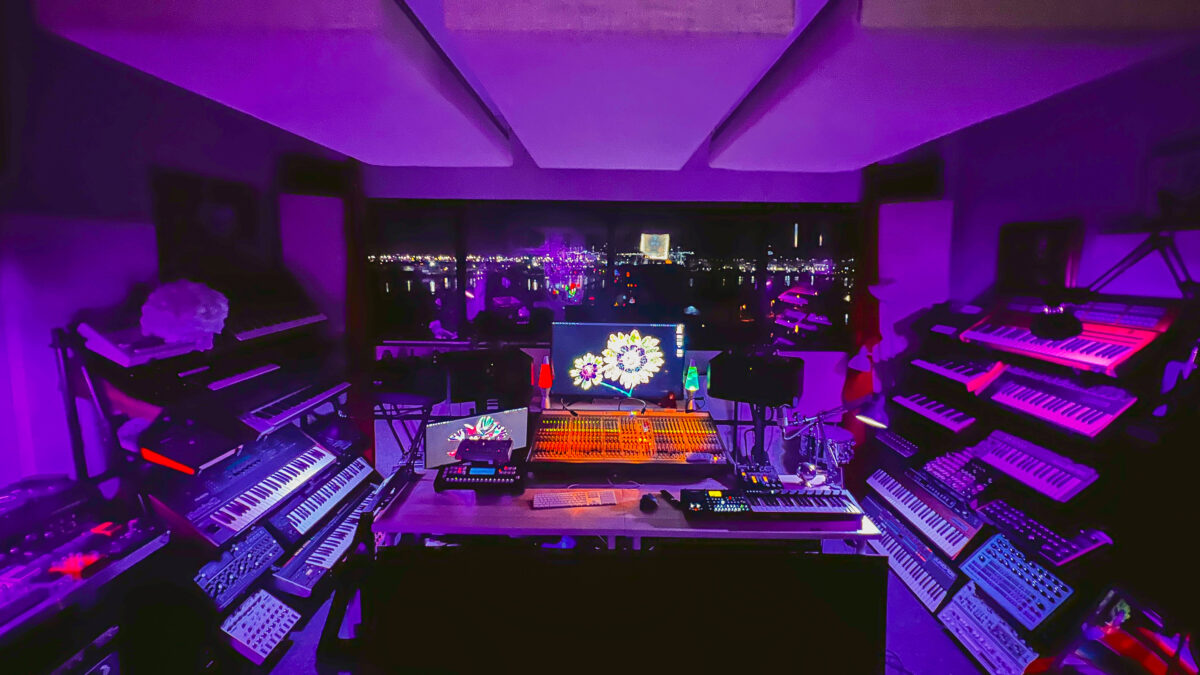
I handle most of my automation and movement this way. Instead of drawing in automation manually – though I still do that when needed – I prefer to jam live with the parameters. That real time interaction brings a more human, dynamic feel to the sound, and often leads to more interesting, expressive results.
I really encourage others to try this approach. It not only makes the workflow more hands-on, but also a lot more fun and creatively engaging. It’s super straightforward: just map any parameter in Guitar Rig to a physical control, hit play/record, and start experimenting.
Pro tip from David Castellani: Try MIDI mapping the individual frequency sliders on the Filter Bank to different faders on a controller and experiment with manipulating and shaping the sound.
For producers looking to integrate Guitar Rig into their techno workflow, where’s a good starting point without overcomplicating things?
A really easy way to get started with Guitar Rig is by diving into the many built-in presets. These are thoughtfully designed and tailored for specific vibes, styles, and emulations. It’s super simple to load one up and apply it to a lead sound or an effect return – your sound can evolve dramatically in just seconds.
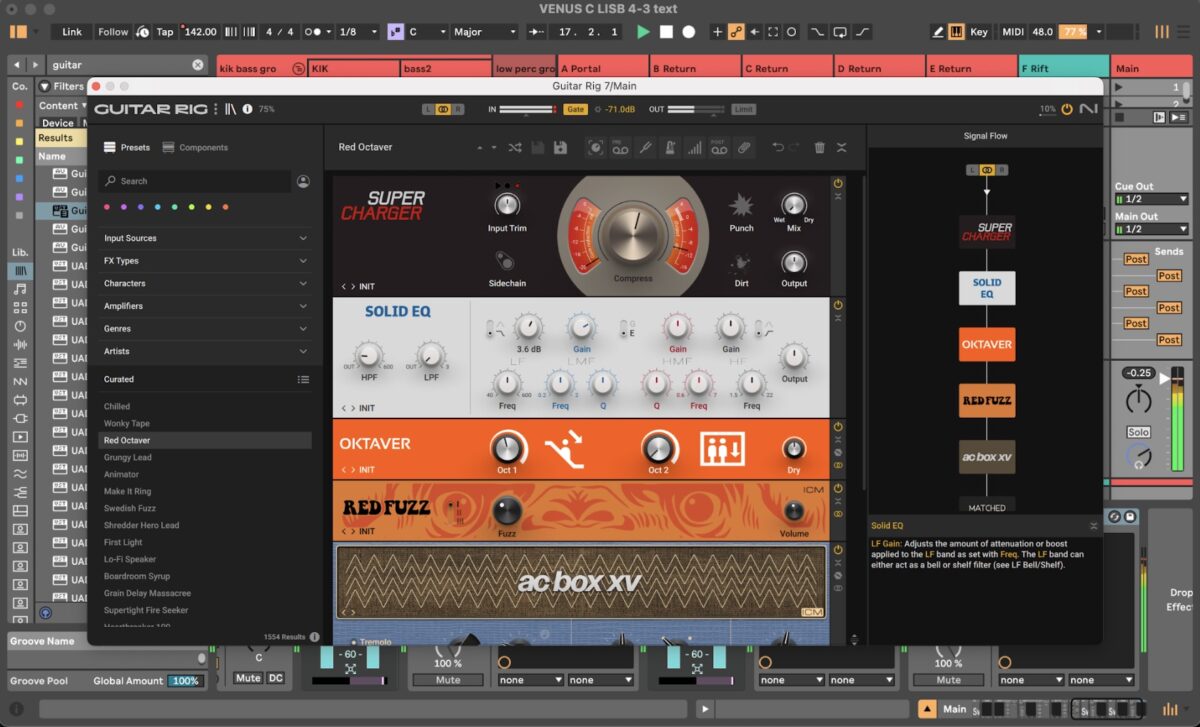
To refine your search, Guitar Rig also includes a preset attribute filter on the left-hand side of the browser. This lets you narrow things down by character, effect type, or instrument, making it easier to find something that fits your vision.
That said, I personally like to lean into the exploratory side of music-making. Instead of rigidly chasing a sound I think I need, I try to stay open to discovery. These tools are incredibly deep – far more expansive than I can hold in memory at any given time – so letting creativity lead the way often produces the most inspiring results.
Pro tip from David Castellani: One of my go-to presets is Black Sun Garden from the legacy Guitar Rig 4 presets. This is one of my favorite jump-off points for dirty and dark processing. Never fails.
In your live setup, is Guitar Rig part of your performance chain or reserved for studio use?
I’ve mostly used it in production environments, while my live setup has leaned more heavily on hardware processing.
That said, I can definitely see it becoming part of my live rig as technology continues to evolve and I grow more comfortable incorporating computer-based processing on stage. It’s a natural progression, and tools like Guitar Rig are more than capable of delivering the flexibility and depth I’d want in a live performance context.
Do you think more techno producers should be looking beyond “traditional” tools – are they sleeping on what Guitar Rig can actually do?
I have to say, I truly believe Guitar Rig deserves a more prominent place in many producers’ toolkits. I think the name itself – “Guitar” Rig – might mislead some into thinking it’s only meant for guitar processing. But to me, it was always clear that this tool goes far beyond that.

Sure, I’ve used it to make synths sound like guitars when I’m chasing a more grungy or rock-inspired vibe – but I’ve also applied it to hundreds of different types of tracks in countless creative ways. It’s consistently expanded my sonic palette and delivered deep, meaningful results across the board.
I highly recommend Guitar Rig to all electronic music producers – not just as a guitar effect, but as a full-blown multi-effects processor. It has the power to take your sound to the next level and elevate your creative process in truly unexpected ways.
Pro tip from David Castellani: Reach into the Ambient or Jazz sections for less intense processing and to find more subtle yet exciting movement in your sounds.
Start using Guitar Rig for effects processing
David Castellani doesn’t keep Guitar Rig around for tradition’s sake. He uses it because it’s one of the few plugins that keeps up with the pace of his ideas.
From tight, aggressive distortion to expressive modulation and subtle movement, it gives him the flexibility to chase whatever mood or momentum he’s after.
If you’re serious about building FX chains that evolve and respond in real time, Guitar Rig is worth the time. Whether you’re pushing synths, sculpting vocals, or warping percussion, it’s a practical way to turn basic signals into signature moments.
